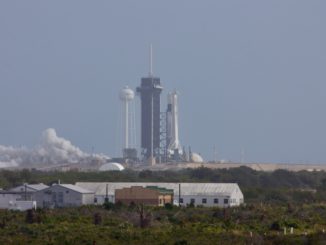
SpaceX successfully launched its Super Heavy-Starship rocket on August 26, 2025, marking a significant milestone in its ambitious space exploration program. The launch took place from the company’s Starbase facility in Texas, two days behind schedule, but resulted in what appeared to be a successful test flight following three consecutive failures earlier in the year.
The mission, referred to as Starship Flight 10, commenced at 19:30 ET when the Super Heavy’s 33 methane-fueled Raptor engines ignited with a powerful roar, propelling the 40-story rocket into the sky. The first stage, Super Heavy, performed as expected, boosting the Starship upper stage out of the lower atmosphere before returning to the Gulf of Mexico for a controlled splashdown.
Throughout the one-hour and six-minute flight, SpaceX personnel celebrated each milestone, particularly after the challenges of previous tests. Although the upper stage experienced some damage during re-entry, including a protective skirt around the engine bay and melting of a control flap, the vehicle maintained stability and executed a powered splashdown in the Indian Ocean as planned.
Elon Musk, the founder of SpaceX, expressed his pride in the team’s achievements via a post on social media platform X, stating, “Splashdown confirmed! Congratulations to the entire SpaceX team on an exciting tenth flight test of Starship!”
Key Flight Details and Challenges
The Super Heavy first stage successfully completed its mission by launching the Starship upper stage and returning toward the Texas Gulf Coast. During a simulated failure, one of the engines was deliberately shut down, but the booster compensated effectively, demonstrating its capabilities during the descent.
The upper stage then achieved a sub-orbital trajectory, a goal that had eluded previous test flights. Over the course of 38 minutes, the Starship deployed eight Starlink satellite simulators and performed a brief re-ignition of one of its six Raptor engines to test its ability to restart in space.
As the vehicle re-entered Earth’s atmosphere, new heat shield tiles were put to the test. While most components functioned normally, the protective skirt and a control flap suffered damage due to the extreme heat. Despite this, the Starship managed to execute a successful flight and splashdown.
Future Implications for SpaceX and NASA
The success of this latest test flight is crucial for SpaceX as it aims to refine the Super Heavy-Starship for operational missions, which include launching numerous Starlink satellites and eventually transporting settlers and equipment to Mars. The company intends to expedite the development process to become operational as soon as possible.
For NASA, the Super Heavy-Starship is essential for its Artemis program, which plans to land astronauts on the Moon by 2027. A modified version of the Starship will be used to transport two astronauts to the lunar surface. This timeline raises concerns, as experts suggest that significant technical hurdles remain.
Current and former NASA managers and engineers have voiced skepticism regarding the feasibility of a crewed Moon landing in 2027 under the existing Human Landing System architecture. A senior engineer involved in the Artemis program noted, “We are not going to go ahead and get a crewed Starship to the moon by 2030, under any circumstances.”
With many challenges ahead, including the need for multiple Super Heavy-tanker flights to refuel the lunar lander, the success of the recent test flight provides a much-needed boost to the SpaceX team. The upcoming months will be critical in determining whether the company can meet its ambitious timelines or if competitors, such as China, will establish a presence on the Moon first.
As SpaceX continues to work through its development phases, the successful launch of the Super Heavy-Starship serves as a promising indicator of the future of space travel and exploration.






